Filter by
Number of Teeth
Roller Chain Trade Number
Shaft Type
Component
System of Measurement
DFARS Specialty Metals
Export Control Classification Number (ECCN)
REACH
RoHS
Shaft Mount Type
Strand Type
Chain Standard
Sprocket Type
Gear Pitch
About Roller Chain and Sprockets
More
About Gears
More
Sprockets for ANSI Roller Chain

With Keyway
Mount these sprockets onto your shaft and secure with a set screw—no machining necessary.
For ANSI 40 Roller Chain (1/2" Pitch)

Keyway | ||||||||||
|---|---|---|---|---|---|---|---|---|---|---|
| Number of Teeth | For Shaft Dia. | OD | Overall Wd. | Hub Dia. | Wd. | Dp. | Material | Includes | Each | |
| 52 | 3/4" | 8.57" | 1 1/8" | 3 1/2" | 3/16" | 3/32" | Steel | Two Set Screws | 00000000 | 0000000 |
| 52 | 7/8" | 8.57" | 1 1/8" | 3 1/2" | 3/16" | 3/32" | Steel | Two Set Screws | 00000000 | 000000 |
| 52 | 1" | 8.57" | 1 1/8" | 3 1/2" | 1/4" | 1/8" | Steel | Two Set Screws | 00000000 | 000000 |
| 52 | 1 1/4" | 8.57" | 1 1/8" | 3 1/2" | 1/4" | 1/8" | Steel | Two Set Screws | 00000000 | 000000 |
| 52 | 1 3/8" | 8.57" | 1 1/8" | 3 1/2" | 5/16" | 5/32" | Steel | Two Set Screws | 00000000 | 000000 |
| 52 | 1 1/2" | 8.57" | 1 1/8" | 3 1/2" | 3/8" | 3/16" | Steel | Two Set Screws | 00000000 | 000000 |
Plastic Gears and Gear Racks—14 1/2° Pressure Angle
A former industry standard, 14½° pressure angle gears are often found on older machinery. Made of plastic, they run quieter than metal gears and have good corrosion and chemical resistance. They’re also known as spur gears.
Combine gears with different numbers of teeth to change speed and torque in your assembly. Combine a gear and rack to convert rotary motion into linear motion.
For components to mesh correctly, they must have the same pressure angle and pitch.
Gears

Gear with Round or
Round/Machinable
Bore
Round/Machinable
Bore

Hub | |||||||||||||
|---|---|---|---|---|---|---|---|---|---|---|---|---|---|
| Gear Pitch | Number of Teeth | Gear Pitch Dia. | OD | Face Wd. | Overall Wd. | For Shaft Dia. | Material | Fabrication | Color | Dia. | Wd. | Each | |
Round Bore | |||||||||||||
| 32 | 52 | 1 5/8" | 1.69" | 3/16" | 0.438" | 1/4" | Nylon Plastic | Molded | White | 0.625" | 0.25" | 00000000 | 000000 |

























